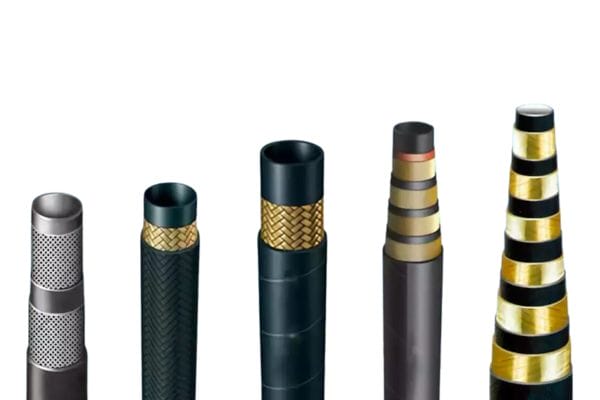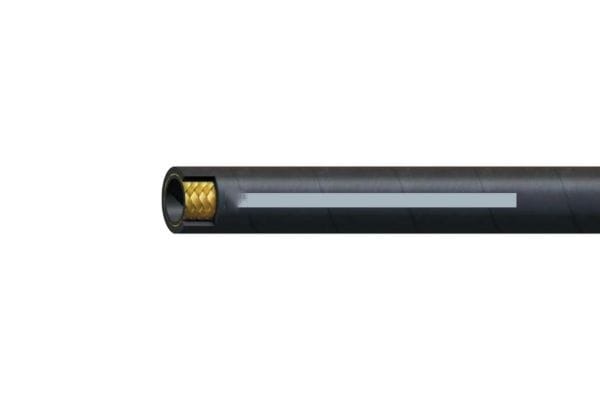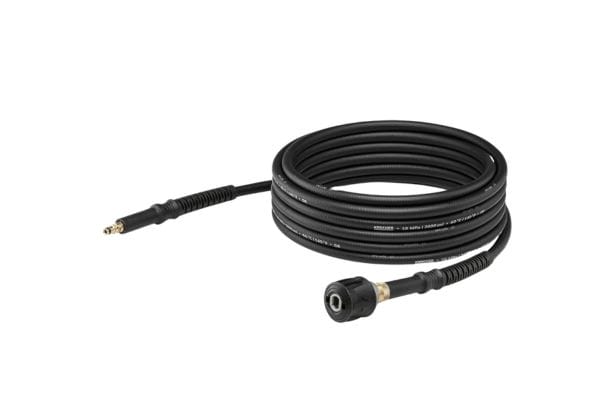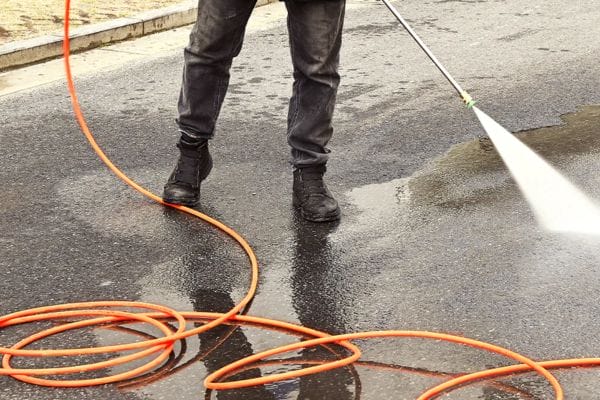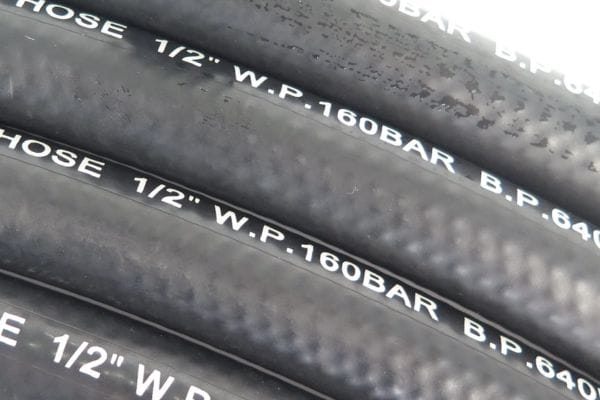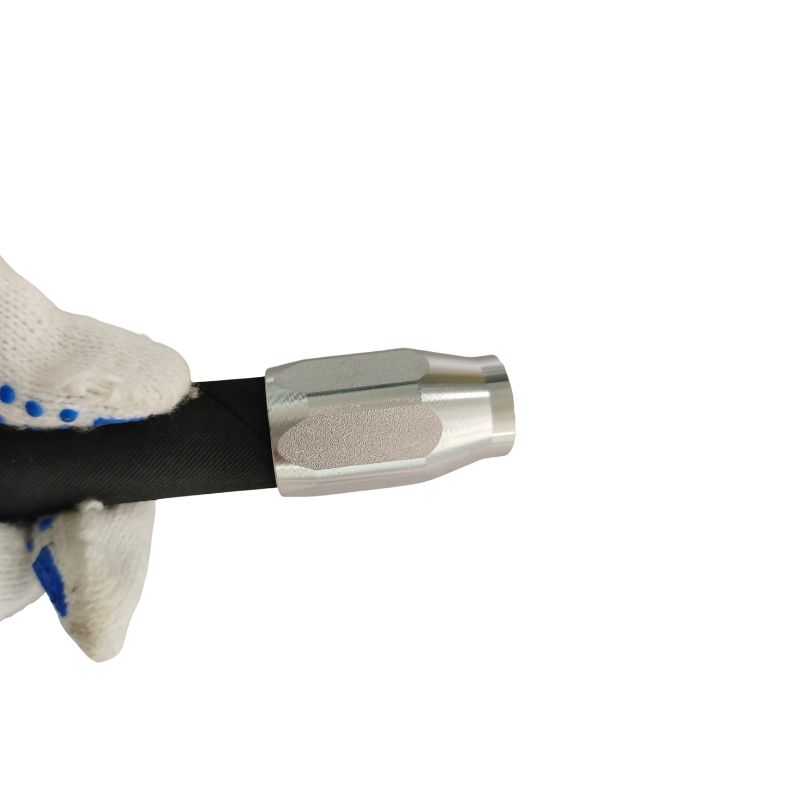Proper fittings ensure efficient fluid flow, reduce the risk of leaks, and enhance overall system performance. With a wide array of options available, selecting the correct fitting can significantly impact the functionality and longevity of hydraulic applications. This decision is particularly crucial in environments where space and maneuverability are limited, choosing between swivel fittings and 90-degree live swivels is vital for operational success.
Understanding Swivel Fittings
A. Definition and Functionality
Swivel fittings are specialized components in hydraulic systems designed to allow rotation between connected parts without twisting or damaging the hoses. They consist of two main components: a fixed part that connects to the hydraulic line and a rotating part that connects to the equipment or tool. This design enables the hoses to move freely, accommodating the natural movements of machinery without compromising fluid integrity or creating tension in the hoses.
In hydraulic systems, swivel fittings function by providing a pivot point that permits unrestricted movement. This flexibility is essential in applications where equipment is in constant motion or where connections need to be repositioned frequently. By allowing for rotation, swivel fittings help maintain proper alignment and prevent wear on hoses, thereby extending the life of the entire hydraulic system.
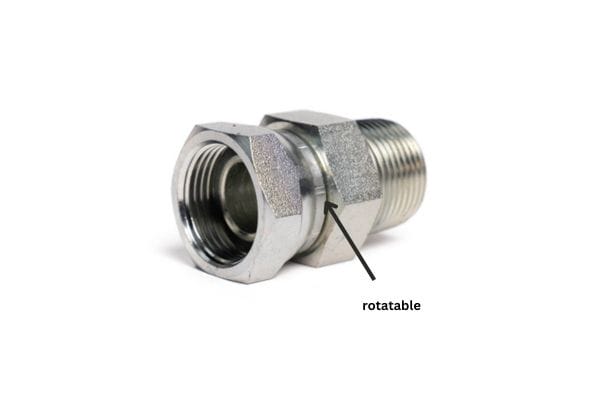
B. Types of Swivel Fittings
Standard Swivel Fittings
These are the most common type, used in a variety of hydraulic applications. They typically consist of a male and female threaded connection that allows for easy installation and disassembly. Standard swivel fittings are available in various sizes and materials to suit different fluid types and pressure ratings.
Special-Purpose Swivel Fittings
Designed for specific applications, these fittings may include features such as higher pressure ratings, corrosion-resistant materials, or unique connection styles. For example, some special-purpose swivel fittings are engineered for extreme temperature environments or to accommodate unique hydraulic fluids, making them indispensable in specialized industries.
C. Advantages of Swivel Fittings
Flexibility and Maneuverability
One of the primary advantages of swivel fittings is their ability to accommodate movement. This flexibility is crucial in dynamic environments, such as construction sites or manufacturing facilities, where equipment is frequently repositioned. Swivel fittings allow for smooth operation without risking damage to the hydraulic lines.
Reduction of Stress on Hoses and Connections
By allowing for rotational movement, swivel fittings minimize the stress exerted on hoses and connections. This reduction in stress helps prevent leaks and prolongs the life of hydraulic components. In systems where hoses are subject to bending or twisting, swivel fittings can significantly enhance reliability and performance.
D. Common Applications
Industrial Machinery
Swivel fittings are widely used in various industrial machines, such as presses, conveyors, and robotic systems. Their ability to handle high pressures while providing flexibility makes them ideal for intricate machinery that requires precise hydraulic control.
Construction Equipment
In construction, equipment such as excavators, backhoes, and cranes often utilize swivel fittings to facilitate movement and maneuverability. The ability to rotate without twisting the hydraulic lines is crucial for the efficient operation of these machines, especially in tight or challenging environments.
Mobile Hydraulic Systems
Swivel fittings are also prevalent in mobile hydraulic systems, such as those found in trucks and agricultural equipment. These applications require components that can withstand the rigors of travel while providing reliable performance. Swivel fittings ensure that hydraulic connections remain intact and functional, even in the most demanding conditions.
Understanding 90 Degree Live Swivels
A. Definition and Functionality
90-degree live swivels are specialized hydraulic fittings designed to enable smooth fluid flow while allowing for a change in direction at a right angle. Unlike standard swivel fittings, which primarily facilitate rotational movement along a single axis, 90-degree live swivels provide a more compact solution by integrating a bend into the fitting itself. This design allows the hydraulic line to change direction while minimizing the need for additional hoses or fittings, making them particularly useful in tight spaces.
The functionality of 90-degree live swivels is centered around their ability to maintain a tight seal while allowing for rotation. This feature is crucial in applications where equipment may be subjected to constant movement or vibration, ensuring that fluid integrity is preserved without the risk of leaks. Additionally, the live swivel feature allows for continuous rotation, which is beneficial for applications that require dynamic movement.
B. Types of 90-degree Live Swivels
Variations in Design
90-degree live swivels come in various designs tailored to specific applications. Some models feature integrated relief valves or pressure ratings that accommodate high-flow systems, while others may include locking mechanisms to prevent unintentional disconnection. These variations allow users to select the appropriate swivel for their operational requirements.
Materials Used
The materials used in 90-degree live swivels can significantly impact their performance and durability. Common materials include stainless steel, brass, and specialized polymers designed to withstand corrosive environments. Selecting the right material ensures longevity and reliability, especially in harsh operating conditions.
C. Advantages of 90-degree Live Swivels
Space-Saving Design
One of the primary benefits of 90-degree live swivels is their space-saving design. By allowing for a right-angle connection, these fittings enable more efficient use of space in machinery and equipment. This feature is particularly advantageous in applications with limited clearance, where traditional fittings may be impractical.
Improved Fluid Flow
The streamlined design of 90-degree live swivels enhances fluid flow by reducing turbulence and minimizing bends in the hydraulic line. This efficiency can lead to better performance of hydraulic systems, as less energy is lost to friction and resistance. Improved fluid flow also contributes to overall system efficiency, making these fittings ideal for high-performance applications.
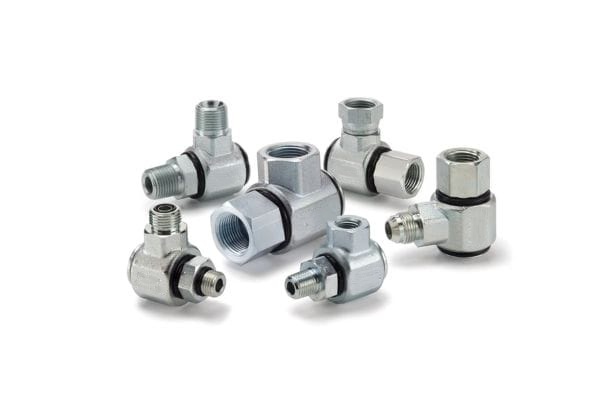
D. Common Applications
Tight Spaces in Machinery
90-degree live swivels are often employed in applications where space is at a premium, such as inside compact machinery or equipment with intricate designs. Their ability to change direction without adding bulk makes them a preferred choice in automotive, aerospace, and industrial machinery.
Applications Requiring Precise Angles
Industries that require precise fluid routing benefit significantly from the use of 90-degree live swivels. For instance, in robotics or automated systems, the ability to maintain accurate angles while ensuring fluid integrity is crucial for performance and reliability. These fittings help achieve the necessary alignment without compromising the functionality of the system.
Key Differences Between Swivel vs 90 Degree Live Swivels
A. Design and Construction
The design of swivel fittings and 90-degree live swivels highlights their distinct purposes in hydraulic systems. Swivel fittings typically feature a straightforward structure consisting of two main components: a stationary connector and a rotating part. This simple design allows for flexibility and movement in various directions, making them ideal for general applications.
In contrast, 90-degree live swivels incorporate an angled design that changes the direction of fluid flow at a right angle. This unique shape not only conserves space but also reduces the number of necessary connections, minimizing potential leak points. Additionally, while standard swivel fittings often have a more open configuration, 90-degree live swivels are constructed to accommodate tighter spaces, enhancing their utility in compact machinery.
B. Performance Characteristics
When it comes to performance, both fitting types excel in specific scenarios. Swivel fittings are praised for their ability to provide flexibility and reduce stress on hoses, making them ideal for systems that experience constant movement. They ensure that hoses remain untangled and free from kinks, promoting efficient fluid transfer.
On the other hand, 90-degree live swivels offer improved fluid flow and a compact design, making them particularly suitable for applications requiring precise directional changes. Their ability to handle high-pressure environments while maintaining a tight seal is a significant advantage. This performance characteristic makes them the preferred choice in situations where space is limited and efficiency is crucial.
C. Installation and Maintenance
Installation processes for swivel fittings and 90-degree live swivels can differ based on their designs. Swivel fittings typically require straightforward threading onto hydraulic lines, allowing for quick setup. However, ensuring proper alignment during installation is essential to avoid undue stress on the hoses.
In contrast, installing 90-degree live swivels may require additional considerations due to their angled design. Proper alignment is critical to ensure that the fluid flows smoothly without obstructions. Moreover, regular maintenance is essential for both types to prevent leaks and ensure longevity. Swivel fittings generally require periodic checks for wear and tear, while 90-degree live swivels may necessitate more frequent inspections due to their complex interactions with other components in tight spaces.
Factors to Consider When Choosing Between the Two
A. Application Requirements
Space Constraints
Assessing the available space is critical when selecting between swivel fittings and 90-degree live swivels. In applications involving tight or confined areas, 90-degree live swivels emerge as the superior choice due to their compact design. This design allows for efficient routing of hydraulic lines, enabling you to navigate around obstacles without needing additional fittings or excessive hose lengths. For example, in machinery where components are closely packed, these live swivels can facilitate better organization and minimize the risk of hose tangling or kinking. Thus, when space is limited, opting for 90-degree live swivels can significantly enhance the overall layout and functionality of the hydraulic system.
Fluid Dynamics
Understanding the fluid dynamics within your hydraulic system is essential for optimal performance. If your application demands flexibility and allows for movement, standard swivel fittings may be more suitable, as they enable a greater range of motion without putting stress on hoses. However, if your system requires precise directional changes while maintaining high flow rates, 90-degree live swivels can deliver the necessary performance. These fittings minimize turbulence and resistance, ensuring efficient fluid transfer even in complex routing situations. Therefore, evaluating the specific fluid dynamics required for your application will guide you toward the most effective fitting type.
B. Environmental Conditions
Temperature
Temperature plays a crucial role in determining the appropriate fittings for your hydraulic system. Different materials respond uniquely to temperature fluctuations, which can affect their durability and performance. For instance, certain plastics may become brittle in extreme cold, while others might soften at high temperatures. Therefore, it’s vital to select fittings that are designed to withstand the specific temperature ranges your application will encounter. For high-temperature environments, fittings made from heat-resistant materials, such as stainless steel or specialized polymers, are ideal. This ensures that the fittings maintain their integrity and functionality over time.
Pressure Ratings
Pressure ratings are another critical factor when choosing between swivel fittings and 90-degree live swivels. Each fitting type has a designated pressure limit that it can safely handle. For applications operating under high pressure, 90-degree live swivels are often preferred due to their robust construction, which typically allows them to withstand greater forces without failure. Conversely, standard swivel fittings may be more appropriate for lower-pressure applications. Always refer to the manufacturer’s specifications to ensure that the chosen fittings are rated for the pressures they will encounter, thereby minimizing the risk of leaks or catastrophic failures.
C. Compatibility with Existing Systems
Ensuring compatibility with existing hydraulic systems is paramount when making your selection. Begin by thoroughly evaluating the current fittings, hoses, and components to determine which type will integrate seamlessly into your setup. If your system already utilizes a specific fitting type, continuing with that design may be more efficient. This approach reduces the need for unnecessary modifications or adaptations, saving both time and resources.
Additionally, consider factors such as connection styles, thread types, and materials to ensure a secure and leak-free integration. For example, if your system uses metric threads, transitioning to fittings with incompatible threads could lead to leaks or system failures. Compatibility not only streamlines installation but also enhances overall system reliability, reducing the risk of issues arising from mismatched components.
Conclusion
When making the right choice, it is important to consider the long-term impact of the decision. The right fitting can improve the performance and longevity of your hydraulic system, while the wrong choice can lead to inefficiency or potential failure. Take the time to thoroughly evaluate your unique requirements and the characteristics of both fitting types before making the right choice. If you have any requirements, please feel free to contact
FAQ
What is the primary function of swivel fittings?
Swivel fittings allow for rotation between connected parts, providing flexibility and preventing hose twisting in hydraulic systems.
How do 90-degree live swivels differ from standard swivel fittings?
90-degree live swivels change the direction of fluid flow at a right angle, making them ideal for tight spaces, while standard swivel fittings provide rotational movement along a single axis.
In what applications are 90-degree live swivels typically used?
They are commonly used in tight spaces in machinery and applications that require precise directional changes without compromising fluid flow.
What factors should I consider when choosing between the two?
Consider application requirements (space constraints and fluid dynamics), environmental conditions (temperature and pressure ratings), and compatibility with existing systems.
Can I use swivel fittings in high-pressure applications?
It depends on the specific swivel fitting’s pressure rating. Always check the manufacturer’s specifications to ensure suitability for high-pressure environments.
What maintenance is required for swivel fittings and 90-degree live swivels?
Regular maintenance includes inspecting for leaks, ensuring that connections are tight, and checking for signs of wear or damage.



